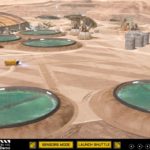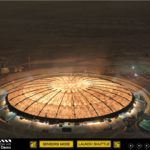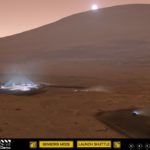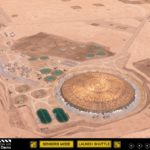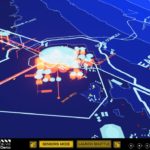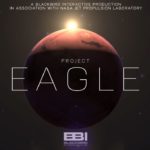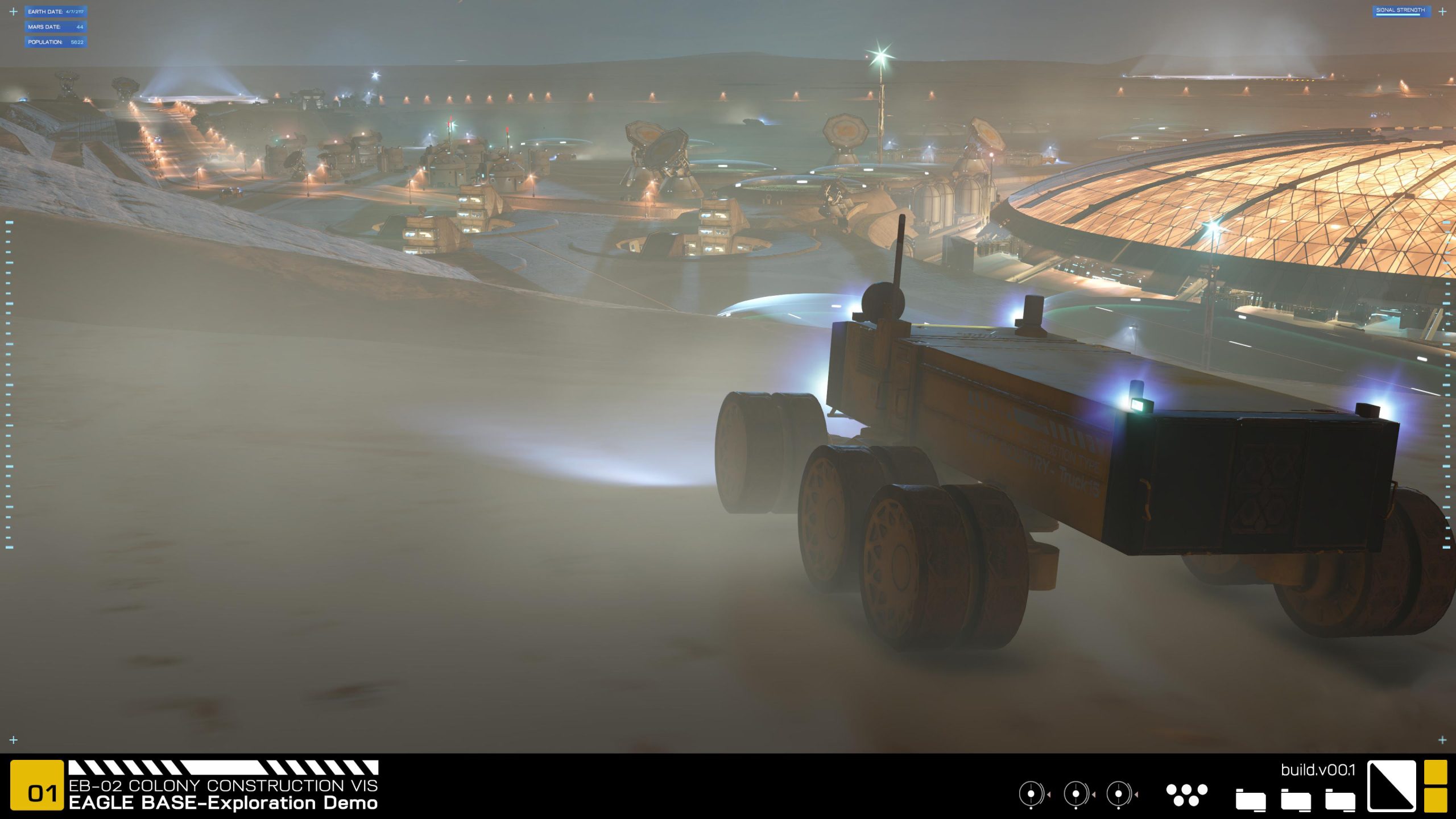
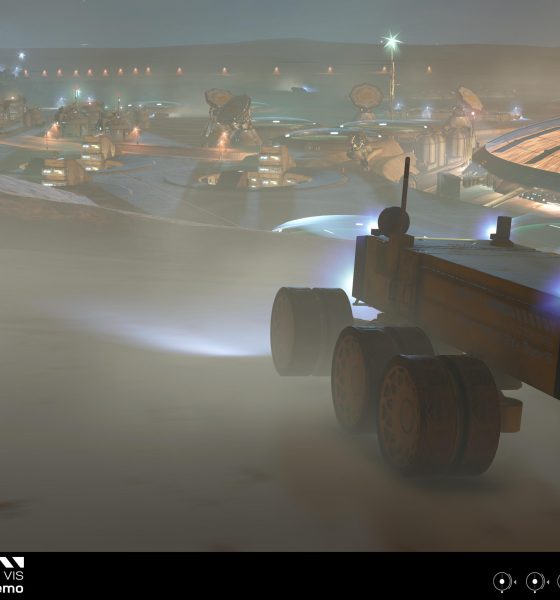
Lifestyle
NASA develops 3D Mars base simulator in collaboration with game studio
NASA’s Jet Propulsion Laboratory (JPL) collaborated with independent game studio Blackbird Interactive (BBI) to create an incredibly realistic interactive 3D Mars base simulation called Project Eagle. Using current science and potential technology development inspired by it, users can venture through the simulation’s multi-level Eagle Base where “past” and “current” colony construction, energy, and habitation projects are on display with infographics explaining their design and overall functionality. The timeline is set 100 years in the future with a red planet population that starts with around 5500 colonists that are visibly carrying out a life among the regolith.
The imagined colony is located in the Gale Crater, an area slightly south of Mars’s equator on the Eastern hemisphere, which is also the same spot NASA’s Mars Curiosity Rover landed on August 6, 2012. In fact, the simulation has a monument set just outside the colony which commemorates Curiosity. The topographical and geographic features are based on actual map data collected by Mars satellites and rovers that were provided to BBI, and through a series of time lapses, users can experience a virtual day, sunsets, nights, and sunrises. This region is also near the Elysium Planitia where NASA’s recently arrived InSight lander is located.
While exploring, users will come across a few unique features in the simulation. The primary region is the “Dome Complex” wherein a very large biodome made possible by Mars’s low gravity -the Eagle Dome – is located, providing an Earth-like ecosystem for the colonists. The dome is shielded from radiation, but enough light is allowed to filter through so that occupants don’t suffer from claustrophobia. The environment also enables spacesuit-free living. To support the dome and other areas where colonists are living and working, multiple algae-ponds have been constructed which generate oxygen and provide a supplemental food source.
- A future human colony on Mars as imagined by Blackbird Interactive in collaboration with NASA’s Jet Propulsion Laboratory. | Credit: Blackbird Interactive
- A future human colony on Mars as imagined by Blackbird Interactive in collaboration with NASA’s Jet Propulsion Laboratory. | Credit: Blackbird Interactive
- A future human colony on Mars as imagined by Blackbird Interactive in collaboration with NASA’s Jet Propulsion Laboratory. | Credit: Blackbird Interactive
- A future human colony on Mars as imagined by Blackbird Interactive in collaboration with NASA’s Jet Propulsion Laboratory. | Credit: Blackbird Interactive
- A future human colony on Mars as imagined by Blackbird Interactive in collaboration with NASA’s Jet Propulsion Laboratory. | Credit: Blackbird Interactive
- A future human colony on Mars as imagined by Blackbird Interactive in collaboration with NASA’s Jet Propulsion Laboratory. | Credit: Blackbird Interactive
A future human colony on Mars as imagined by Blackbird Interactive in collaboration with NASA’s Jet Propulsion Laboratory. | Credit: Blackbird Interactive
Outside of the dome are condo-blocks providing primary residencies to the planet’s human occupants. These have been constructed using Mars-native materials and connect to a system of underground tunnels, also areas protected from radiation where colonists can live without pressurized suits. To realistically show the progress made in the colonization effort, legacy “hab” pods and an old launch pad are present, complete with little blurbs about the colony’s development history.
Additionally, power is provided via nuclear fission reactors, the Uranium for which is provided from Earth every few years on resupply missions. Water treatment facilities connected to Martian water wells are also present along with several satellite dishes forming a communications array where Martian internet has been established. When visitors are ready to leave, a shuttle launch animation is available, sending off a flattened winged craft from a receded launch facility, thereby exiting the simulation.
Project Eagle was first introduced in 2017 at the annual D.I.C.E. (Design, Innovate, Communicate, Entertain) Summit hosted by the Academy of Interactive Arts & Sciences. In the presentation hosted by Dr. Jeff Norris, Mission Operations Innovation Lead of NASA’s JPL, video game creators were encouraged to utilize their tools – games – to do more than just entertain and amuse their audience. He made a case for art as inspiration for a plausible vision for the future of space exploration. “Great art doesn’t just move us as individuals – it can move entire societies,” he stated on stage. He further cited the connection between the originator of “space art”, artist Chelsey Bonestell, and the public’s directly inspired support of the later Moon missions. The simulation was made available for use by attendees and is now available through Steam.
For more on Project Eagle and to see the 2017 DICE presentation by Dr. Norris and BBI, watch the video below:

Lifestyle
Tesla Model S Plaid battles China’s 1500 hp monster Nurburgring monster, with surprising results
There is just something about Tesla’s tuning and refinement that makes raw specs seem not as game-changing.

The Tesla Model S Plaid has been around for some time. Today, it is no longer the world’s quickest four-door electric sedan, nor is it the most powerful. As per a recent video from motoring YouTube channel Carwow, however, it seems like the Model S Plaid is still more than a match for some of its newer and more powerful rivals.
The monster from China
The Xiaomi SU7 Ultra is nothing short of a monster. Just like the Model S Plaid, it features three motors. It also has 1,548 hp and 1,770 Nm of torque. It’s All Wheel Drive and weighs a hefty 2,360 kg. The vehicle, which costs just about the equivalent of £55,000, has been recorded setting an insane 7:04.957 at the Nurburgring, surpassing the previous record held by the Porsche Taycan Turbo GT.
For all intents and purposes, the Model S Plaid looked outgunned in Carwow’s test. The Model S Plaid is no slouch with its three motors that produce 1,020 hp and 1,420 Nm of torque. It’s also a bit lighter at 2,190 kg despite its larger size. However, as the Carwow host pointed out, the Model S Plaid holds a 7:25.231 record in the Nurburgring. Compared to the Xiaomi SU7 Ultra’s record, the Model S Plaid’s lap time is notably slower.
Real-world tests
As could be seen in Carwow’s drag races, however, Tesla’s tech wizardry with the Model S Plaid is still hard to beat. The two vehicles competed in nine races, and the older Model S Plaid actually beat its newer, more powerful counterpart from China several times. At one point in the race, the Xiaomi SU7 Ultra hit its power limit due to its battery’s temperature, but the Model S Plaid was still going strong.
The Model S Plaid was first teased five years ago, in September 2020 during Tesla’s Battery Day. Since then, cars like the Lucid Air Sapphire and the Xiaomi SU7 Ultra have been released, surpassing its specs. But just like the Model Y ended up being the better all-rounder compared to the BYD Sealion 7 and the MG IM6, there is just something about Tesla’s tuning and refinement that makes raw specs seem not as game-changing.
Check out Carwow’s Model S Plaid vs Xiaomi SU7 drag race video below.
Lifestyle
500-mile test proves why Tesla Model Y still humiliates rivals in Europe
On paper, the BYD Sealion 7 and MG IM6 promised standout capabilities against the Model Y.

BYD is seeing a lot of momentum in Europe, so much so that mainstream media has taken every opportunity to argue that the Chinese automaker has beaten Tesla in the region. But while BYD sales this year in Europe are rising and Tesla’s registrations remain challenged, the raw capabilities of vehicles like the Model Y are difficult to deny.
This was highlighted in a 500-mile challenge by What Car? magazine, which showed that the new Tesla Model Y is more efficient, cheaper to run, and more reliable than rivals like the BYD Sealion 7, and even the nearly 400 KW-charging MG IM6.
Range and charging promises
On paper, the BYD Sealion 7 and MG IM6 promised standout capabilities against the Model Y. The Sealion 7 had more estimated range and the IM6 promised significantly faster charging. When faced with real-world conditions, however, it was still the Model Y that proved superior.
During the 500-mile test, the BYD nearly failed to reach a charging stop, arriving with less range than its display projected, as noted in a CarUp report. MG fared better, but its charging speeds never reached its promised nearly-400 kW charging speed. Tesla’s Model Y, by comparison, managed energy calculations precisely and arrived at each stop without issue.
Tesla leads in areas that matter
Charging times from 25% to 80% showed that the MG was the fastest at 17 minutes, while Tesla and BYD were close at 28 and 29 minutes, respectively. Overall efficiency and cost told a different story, however. The Model Y consumed 19.4 kWh per 100 km, compared to 22.2 for MG and 23.9 for BYD. Over the full trip, Tesla’s charging costs totaled just £82 thanks to its supercharger network, far below BYD’s £130 and MG’s £119.
What Car? Magazine’s testers concluded that despite BYD’s rapid sales growth and the MG IM6’s seriously impressive charging speeds, Tesla remains the more compelling real-world choice. The Model Y just offers stability, efficiency, and a proven charging infrastructure through its Supercharging network. And as per the magazine’s hosts, the Model Y is even the cheapest car to own among the three that were tested.
Watch What Car? Magazine’s 500-mile test in the video below.
Lifestyle
Tesla Cybertruck slapped with world’s least intimidating ticket, and it’s pure cringe
One cannot help but cringe and feel second-hand embarrassment at the idea of a person just driving around with a stack of these babies.

A Cybertruck parked at Stanford Shopping Center in California was recently hit with what might be the most try-hard piece of paper ever slipped under a wiper blade: a “fake citation” accusing the driver of supporting a “fascist car.”
The note, shared on X by Tesla staff program manager Ryan Torres, quickly made the rounds on X, where it quickly gained attention as an example of how not to protest.
The world’s least intimidating ticket
According to the citation, the supposed “violation” was “driving a fascist car.” The remedial action? Take the bus, call an Uber, or ride a bike. The note also dubbed Elon Musk a “chainsaw-wielding Nazi billionaire.” Now, protests against Tesla and Elon Musk have become commonplace this year, but one cannot help but cringe and feel second-hand embarrassment at the idea of a person just driving around with a stack of fake anti-Tesla/Musk citations.
Torres pointed out the irony himself in his post on X. Tesla currently employs over 140,000 Americans, and SpaceX has put the U.S. firmly back at the top of space technology. As Torres put it, maybe the person behind the world’s least intimidating ticket should “read a book on innovation before vandalizing” other people’s property.
Peak performative clownery
Not to mention that the fake ticket’s logic collapses under its own weight. EVs like the Cybertruck are literally designed to reduce emissions, not “destroy the economy.” If anything, Tesla has bolstered the United States’ economy by fueling jobs in engineering, manufacturing, and clean energy. It’s not the first time a Tesla has been the target of vandalism or politically charged notes, but this one stands out for sheer cringe value.
Torres summed it up neatly: “Peak clownery.” On that point, at least, the citation earns full marks. In a way, though, perhaps cringe fake tickets are not as bad as the literal firebombs that were being thrown at Tesla stores and cars earlier this year because some critics were gleefully misinformed about Elon Musk.
